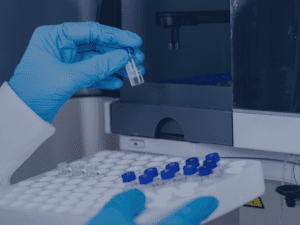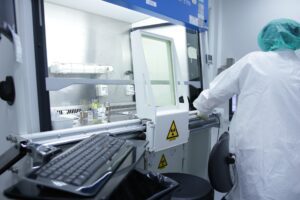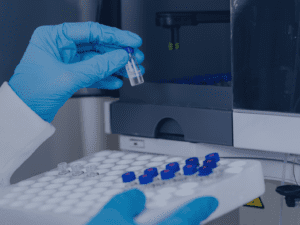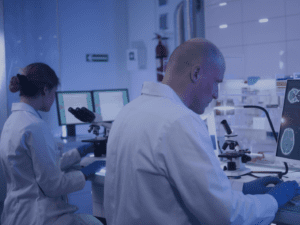RCH Achieves AWS Life Sciences Competency
Leading Cloud solutions exclusively for Life Sciences teams that accelerate discovery, optimize costs and ensure scalability and compliance in AWS.
As research becomes increasingly data-driven, the need for a robust IT infrastructure, coupled with a team that can navigate the complexities of bioinformatics, is vital to progress. But what happens when your in-house Bio-IT services team encounters challenges beyond their capacity or expertise?
This is where strategic augmentation comes into play. It’s not just a solution but a catalyst for innovation and growth by addressing skill gaps and fostering collaboration for enhanced research outcomes.
The pace of innovation demands an agile team and diverse expertise. A thorough evaluation of your in-house Bio-IT team’s capabilities is the foundational step in this process. It involves a critical analysis of strengths and weaknesses, identifying both skill gaps and bottlenecks, and understanding the nuances of your team’s ability to handle the unique demands of scientific research.
For startup and emerging Biotech organizations, operational pain points can significantly alter the trajectory of research and impede the desired pace of scientific advancement. A comprehensive blueprint that includes team design, resource allocation, technology infrastructure, and workflows is essential to realize an optimal, scalable, and sustainable Bio-IT vision.
Traditional models of sourcing tactical support often clash with these needs, emphasizing the necessity of a Bio-IT Thought Partner that transcends typical staff augmentation and offers specialized experience and a willingness to challenge assumptions.
Before sourcing the right resources to support our team, it’s essential to identify where the gaps lie. Start by:
Once you’ve identified the gaps, the next step is to find the right partners to fill them. Here’s how:
Merging in-house and external teams can be challenging. However, with the right strategies, collaboration can lead to unparalleled research outcomes.
For IT professionals and decision-makers in Pharma, Biotech, and Life Sciences, the decision to augment the in-house Bio-IT team is not just about filling gaps; it’s about propelling research to new heights, ensuring that the IT infrastructure is not just supportive but also transformative.
When making this decision, consider the long-term implications. While immediate project needs are essential, think about how this augmentation will serve your organization in the years to come. Will it foster innovation? Will it position you as a leader in the field? These are the questions that will guide you toward the right choice.
Life Science research outcomes can change the trajectory of human health, so there’s no room for compromise. Augmenting your in-house Bio-IT team is a commitment to excellence. It’s about recognizing that while your team is formidable, the right partners can make them invincible. Strength comes from recognizing when to seek external expertise.
Pick the right team to supplement yours. Talk to RCH Solutions today.
Sources:
http://www.rchsolutions.com/harnessing-collaboration/
http://www.rchsolutions.com/press-release-rch-introduces-solution-offering-designed-to-help-biotech-startups/
http://www.rchsolutions.com/what-is-a-bio-it-thought-partner-and-why-do-you-need-one/
http://www.rchsolutions.com/our-people-are-our-key-point-of-difference/
https://www.ncbi.nlm.nih.gov/pmc/articles/PMC3652225/
https://www.forbes.com/sites/forbesbusinesscouncil/2023/01/10/three-best-practices-when-outsourcing-in-a-life-science-company/?sh=589b57a55575
https://www.cio.com/article/475353/avoiding-the-catch-22-of-it-outsourcing.html
In the Life Sciences, analyzing vast datasets like genomic sequences or clinical trial results is routine. Ensuring the security and integrity of this data is crucial, especially under tight regulatory oversight.
Amazon Web Services (AWS) provides a platform with certified experts that cater to these needs. AWS offers tools that help streamline data processes, meet compliance standards, and safeguard intellectual property. The key is to use these tools efficiently to maintain data integrity and confidentiality.
AWS solutions are designed to meet the specific demands of Life Sciences, such as upholding GxP compliance and guarding sensitive patient data. By aligning with these requirements, organizations can adhere to regulatory standards while tapping into the benefits of Cloud technology. Moreover, AWS’s voluntary participation in the CSA Security, Trust & Assurance Registry (STAR) Self-Assessment showcases its transparency in compliance with best practices, establishing even more trust for users.
AWS’s commitment to integrating compliance controls means it’s woven through the entire system, from data centers to intricate IT processes. For example, when handling genomic data, AWS ensures encrypted storage for raw sequences, controlled access for processing, and traceable logs for any data transformations, all while adhering to regulatory standards.
This tailored AWS infrastructure offers Life Sciences organizations unparalleled control. Imagine researchers working on a groundbreaking vaccine. As they collect vast amounts of patient data, they need a system that can not only securely store this information but also track every modification or access to it.
With AWS, an automatic log is generated each time a researcher accesses or modifies a patient’s record. This means that six months later, if there’s a question about who made a specific change to a patient’s data, the researchers can quickly pull up this log, verifying the exact date, time, and individual responsible. Data management on AWS is about ensuring data is traceable, consistent, and always under the organization’s purview.
Life Sciences data, whether it’s genomic sequences or computational studies, needs robust security. This data’s sensitivity and proprietary nature mean any breach could harm research outcomes, patient confidentiality, and intellectual property rights.
To tackle these concerns, AWS provides:
Navigating the maze of regulatory requirements in the Life Sciences sector can be daunting. AWS offers tools designed specifically to ease this journey.
AWS Artifact stands out as it provides on-demand access to AWS’s compliance reports. With information at their fingertips, companies can confidently maintain regulatory compliance without the traditional runaround of audit requests.
Further strengthening the compliance arsenal, AWS Config offers a dynamic solution. Rather than periodic checks, AWS Config continuously monitors and records the configurations of AWS resources. For instance, if a Life Sciences firm were to deploy a genomic database, AWS Config would ensure its settings align with internal policies and external regulatory standards. Utilizing machine learning, AWS Config can also predict and alert potential non-compliance issues before they become critical.
This continuous oversight eliminates gaps that might arise between audits, allowing for consistent adherence to the best practices and regulatory norms.
AWS provides a solid foundation for data management and compliance, but sometimes, specific industries demand specialized solutions. This is where third-party tools like Turbot come into play. It’s tailored for sectors such as Life Sciences thanks to its real-time automation, governance, and compliance features.
Consider a pharmaceutical company conducting clinical trials across multiple countries, each with unique compliance criteria. Turbot ensures that every AWS resource aligns with these diverse regulations, minimizing non-compliance risks.
Beyond mere monitoring, if Turbot detects any discrepancies or non-compliant resources, it immediately rectifies the situation without waiting for human intervention. This proactive approach ensures robust security measures are consistently in place.
Life Science industries operate within complex regulatory landscapes, and handling vast datasets requires meticulous attention to security, traceability, and compliance. AWS’s platform is designed to cater to these needs with sophisticated tools for data governance, security, and audit preparedness, however, without a specialized Life Sciences scientific computing provider with deep AWS expertise, like RCH, you may be leaving AWS opportunities and capabilities in the balance. To maximize the potential of these tools and navigate the intricate junction where science and IT overlap in the AWS Cloud, and beyond, a subject matter expert is crucial.
Contact our certified AWS experts to empower your research with specialized Bio-IT expertise and help streamline your journey to groundbreaking discoveries.
Sources:
https://aws.amazon.com/solutions/health/data-security-and-compliance/
https://aws.amazon.com/health/solutions/gxp/
http://www.rchsolutions.com/cloud-computing/
https://aws.amazon.com/health/genomics/
https://aws.amazon.com/solutions/case-studies/innovators/moderna/
https://aws.amazon.com/compliance/data-center/controls/
https://aws.amazon.com/blogs/aws/new-aws-config-rules-now-support-proactive-compliance/
https://turbot.com/guardrails/blog/2018/11/healthcare-and-life-sciences
https://turbot.com/guardrails/blog/2018/04/gartner-cspm
http://www.rchsolutions.com/resource/elevated-perspectives-security-in-the-cloud/
While computer-assisted drug discovery has been around for 50 years, the need for advanced computing tools has never been so crucial.
 Today, machine learning is proving invaluable in managing some of the intricacies of R&D and powering breakthroughs thanks to its ability to process millions of data points in mere seconds.
Today, machine learning is proving invaluable in managing some of the intricacies of R&D and powering breakthroughs thanks to its ability to process millions of data points in mere seconds.
Of course, AI drug discovery and development tools have their own complex operational demands. Ensuring their integration, operation, and security requires high-performance computing and tools that help manage and make sense of massive data output.
The process of creating and refining pharmaceuticals and biologics is becoming more complex, precise, and personalized, largely due to the robust toolkit of artificial intelligence. As a result, combining complex scientific disciplines, AI-aided tools, and expansive IT infrastructure has come to pose some interesting challenges.
Now, drug discovery and development teams require tools and AI that can:
Drug discovery and development calls for a sophisticated toolset. The following challenges demonstrate the obstacles such tools must overcome.
As we can see, high-level Bio-IT isn’t just an advantage; it’s a necessity. And it’s one that requires the right infrastructure and expertise from an experienced IT partner.
 Bridging the nuances of drug discovery with the technicalities of artificial intelligence demands specialized knowledge, including:
Bridging the nuances of drug discovery with the technicalities of artificial intelligence demands specialized knowledge, including:
Without the right Bio-IT infrastructure and expertise, AI drug discovery cannot reach its full potential. Integrating algorithms, data processing, and computational methods is essential, but it’s their combined synergy that truly sparks groundbreaking discoveries.
As the pharmaceutical industry advances, machine learning is guiding drug discovery and development to unprecedented heights through enabling the creation of sophisticated data models.
By entrusting scientific computing strategies and execution to experts who understand the interplay between research, technology, and compliance, research teams can remain focused on their primary mission: groundbreaking discoveries.
Get in touch with our team if you’re ready to start a conversation about harnessing the full potential of Bio-IT for your drug discovery endeavors.
 Finding the right Bio-IT partner to navigate the complex landscape that is science-IT is no easy task. With a multitude of factors to consider (such as expertise, outcomes, scalability, data security, and adherence to industry regulations), evaluating potential partners can be an overwhelming process. That’s where a Bio-IT scorecard approach comes in handy.
Finding the right Bio-IT partner to navigate the complex landscape that is science-IT is no easy task. With a multitude of factors to consider (such as expertise, outcomes, scalability, data security, and adherence to industry regulations), evaluating potential partners can be an overwhelming process. That’s where a Bio-IT scorecard approach comes in handy.
By using a structured evaluation approach, organizations can focus on what truly matters—aligning their organizational requirements with the capabilities and expertise of potential Bio-IT partners. Not the other way around. Here’s how using a scorecard can help streamline decision-making and ensure successful collaborations.
Every Biopharma is on a mission, whether it’s to develop and deliver new, life-changing therapeutics, or advance science to drive innovation and change. While they share multiple common needs, such as the ability to process large and complex datasets, the way in which each organization uses IT and technology can vary.
Biopharma companies must assess how well their current or potential Bio-IT partner’s services align with the organization’s unique computing needs, such as data analysis, HPC, cloud migration, or specialized software support. And that’s where a Bio-IT scorecard can be helpful. For example, a company with multiple locations must enable easy, streamlined data sharing between facilities while ensuring security and authorized-only access. A single location may also benefit from user-based privileges, but their needs and processes will vary since users are under the same roof.
Organizations must also evaluate the partner’s proficiency in addressing specific Bio-IT challenges relevant to their operations by asking questions such as:
Questions like these on your own Bio-IT scorecard can help your organization better understand a potential partner’s proficiency in areas specific to your needs and objectives. And this ultimately helps your team understand if the partner is capable of helping prepare your firm scale by reducing bottlenecks and clearing a path to discovery.
 Organizations can rate their shortlist partners on relevant technologies, platforms, and scientific computing to learn more about technical proficiency. It’s equally important to apply proficiency to the unique needs of Biopharmas.
Organizations can rate their shortlist partners on relevant technologies, platforms, and scientific computing to learn more about technical proficiency. It’s equally important to apply proficiency to the unique needs of Biopharmas.
According to a industry survey, respondents agree that IT and digital innovation are needed to solve fundamental challenges that span the entire spectrum of operations, including “dedicated funding (59%), a better digital innovation strategy (49%), and the right talent (47%) to scale digital innovation.” It’s essential that IT partners can connect solutions to these and other business needs to ensure organizations are poised for growth.
It’s also critical to verify the partner’s track record of delivering Bio-IT services to organizations within the Life Sciences industry specifically. And the associated outcomes they’ve achieved for similar organizations. To do this, organizations can obtain references and ask specific questions about technical expertise, such as:
Successful IT partners are those who can speak from a place of authority in both science and IT. This means being able to understand the technical aspect as well as applying that technology to the nuances of companies conducting pre-clinical and clinical R&D. While IT companies are highly skilled in the former, very few are specialized enough to also embrace the latter. It’s essential to work with a specialized partner that understands this niche segment – the Life Sciences industry. And creating a Bio-IT scorecard based on your unique needs can help you do that.
IT companies make it their goal to provide optimal solutions to their clients. However, they must also absorb their clients’ goals as their own to ensure they’re creating and delivering the technology needed to drive breakthroughs and accelerate discovery and time-to-value.
Assess how well the partner’s capabilities and services align with your specific research objectives and requirements by asking:
The more experience in servicing research areas that are similar to yours, the less guesswork involved and the faster they can implement optimal solutions.
In the rapidly evolving field of Life Sciences, data generation rates are skyrocketing, making scalability and extensibility vital for future growth. Each project may require unique analysis pipelines, tools, and integrations with external software or databases. A Bio-IT partner should be able to customize its solutions based on individual requirements and handle ever-increasing volumes of data efficiently without compromising performance. To help uncover their ability to do that, your team might consider:
By choosing a Bio-IT partner that prioritizes flexibility and scalability, organizations can future-proof their research infrastructure from inception. They can easily scale up resources as their data grows exponentially while also adapting to changing scientific objectives seamlessly. This agility allows scientists to focus more on cutting-edge research rather than getting bogged down in technical bottlenecks or outdated systems. The potential for groundbreaking discoveries in healthcare and biotechnology becomes even more attainable.
In an industry governed by strict regulations such as HIPAA (Health Insurance Portability and Accountability Act) and GDPR (General Data Protection Regulation), partnering with a Bio-IT company that is fully compliant with these regulations is essential. Compliance ensures that patient privacy rights are respected, data is handled ethically, and legal implications are avoided.
As part of your due diligence, you should consider the following as it relates to a potential partner’s approach to data security and regulatory compliance:
A strong partnership relies on open lines of communication, where both parties can share and leverage their subject matter expertise in order to work towards a common goal. Look for partners who have experience working with diverse and cross-functional teams, and have successfully integrated technology into various workflows.
Evaluate the partner’s communication channels, responsiveness, and willingness to collaborate effectively with the organization’s IT team and other important stakeholders. Consider their approach to project management, reporting, and transparent communication, and how it aligns with your internal processes and preferences.
The value of developing and using a Bio-IT scorecard to ensure a strong alignment between the organization’s Bio-IT needs and the right vendor fit cannot be overstated. Using a scorecard model gives you a holistic, systematic, objective way to evaluate potential or current partners to ensure your needs are being met—and expectations hopefully exceeded.
Biotechs and Pharmas can benefit greatly from specialized Bio-IT partners like RCH Solutions. With more than 30 years of exclusive focus servicing the Life Sciences industry, organizations can gain optimal IT solutions that align with business objectives and position outcomes for today’s needs and tomorrow’s challenges. Learn more about what RCH Solutions offers and how we can transform your Bio-IT environment.
https://www.genome.gov/genetics-glossary/Bioinformatics
In today’s fast-paced and rapidly evolving world of Life Sciences, successful organizations know innovation is the key to success. But game-changing innovation without effective collaboration is not possible.
Think about it. Bringing together diverse minds, specialized skill sets, and unique perspectives is crucial for making breakthroughs in scientific research, data analysis, and clinical advancements. It’s like the X-factor that can unlock new discoveries, achieve remarkable results, and fast-track time-to-value.
In leading RCH and working with dozens of different teams across the Life Sciences space, I’ve seen what works—some things better than others—within organizations looking to foster a greater sense of collaboration to drive innovation.
One of the critical advantages of collaboration in the Life Sciences is the ability to leverage diverse perspectives and expertise. But traditionally, many organizations have functioned within siloed structures, with each department working independently towards their goals. However, this approach often leads to fragmented progress, limited knowledge sharing, and missed opportunities. By embracing cross-functional collaboration, Life Sciences organizations can break down these barriers and foster an environment that encourages the free flow of ideas, expertise, and resources. As the saying goes, “Two heads are better than one,” which is all the more true in the case of collaboration—the potential for breakthrough solutions expands exponentially.
By collaborating with specialized service providers, organizations can leverage their expertise and extend to a broader ecosystem to help streamline processes, implement robust data management strategies, and ensure compliance with regulatory requirements. Such partnerships bring fresh perspectives, complementary expertise and can help drive efficiencies, by leveraging specialized resources, experience and expertise. This ultimately allows Life Sciences companies to focus on their core competencies—research and science.
Life Sciences is a multidisciplinary field that requires expertise in biology, research and development, information technology, data analysis, and more. Creating cross-functional teams that bring together individuals with diverse backgrounds can foster creativity and innovation through the pooling of data, the sharing of insights, and the generation of new hypotheses—ultimately leading to faster insights and more meaningful outcomes. When scientists, data analysts, bioinformaticians, software developers, and domain experts collaborate, they can collectively develop novel solutions, generate new insights, and optimize processes—more efficiently.
Collaboration and the power of strategic partnerships allows Life Sciences organizations to tackle complex problems—and opportunities—from multiple angles. By leveraging the collective intelligence of cross-functional teams, and external specialists, organizations can tap into a wealth of knowledge and experience. This enables them to analyze challenges from different perspectives, identify potential blind spots, and develop comprehensive solutions. The synergy created by collaboration often leads to breakthrough discoveries and more efficient problem-solving.
As we all know, technology is constantly evolving, and keeping pace with the latest advancements can be a daunting task. Collaborating with the right Bio-IT partner helps Life Sciences organizations remain at the forefront of innovation. By fostering partnerships with R&D IT experts, organizations gain access to cutting-edge tools, methodologies, and insights, enabling them to adopt new technologies swiftly and effectively. The ideal Bio-IT partner also has a deep understanding of the complete life cycle of the Cloud journey, for both enterprise and emerging Biopharmas, and from inception to optimization and beyond, enabling them to provide tailored and specialized support at any stage of their distinct Cloud journey. This ultimately assists them in attaining their individual discovery goals and again, allows scientists the bandwidth to focus on their core competencies—research, science and discovery.
In the world of Life Sciences, I truly believe that collaboration, both internally through cross-functional teams, and externally through strategic partnerships, is the key to unlocking transformative breakthroughs. And organizations that aren’t focused on creating and sustaining a collaborative culture or cross-functional strategy? They’ll get left behind.
By harnessing collaboration, organizations can tap into a wealth of knowledge that can drive innovation, enhance problem-solving capabilities, and adapt to rapid technological advances. Embracing collaboration not only accelerates progress but also cultivates a culture of continuous learning and excellence. And the latter is the type of organization that top talent will flock to and thrive within.
As a leading Bio-IT organization, the team at RCH Solutions believes that it is essential to prioritize collaboration, foster meaningful partnerships, and nurture cross-functional teams to shape the future of the Life Sciences industry. Why? Because we’ve seen the accelerative power it brings—driving breakthroughs, accelerating discovery and smashing outcomes—time and time again.
Data pipelines are simple to understand: they’re systems or channels that allow data to flow from one point to another in a structured manner. But structuring them for complex use cases in the field of genomics is anything but simple.
Genomics relies heavily on data pipelines to process and analyze large volumes of genomic data efficiently and accurately. Given the vast amount of details involving DNA and RNA sequencing, researchers require robust genomics pipelines that can process, analyze, store, and retrieve data on demand.
It’s essential to build genomics pipelines that serve the various functions of genomics research and optimize them to conduct accurate and efficient research faster than the competition. Here’s how RCH is helping your competitors implement and optimize their genomics data pipelines, along with some best practices to keep in mind throughout the process.
Whether you’re creating a new data pipeline for your start-up or streamlining existing data processes, your entire organization will benefit from laying a few key pieces of groundwork first. These decisions will influence all other decisions you make regarding hosting, storage, hardware, software, and a myriad of other details.
Defining the problem and data requirements
All data-driven organizations, and especially the Life Sciences, need the ability to move data and turn them into actionable insights as quickly as possible. For organizations with legacy infrastructures, defining the problems is a little easier since you have more insight into your needs. For startups, a “problem” might not exist, but a need certainly does. You have goals for business growth and the transformation of society at large, starting with one analysis at a time. So, start by reviewing your projects and goals with the following questions:
Leaning into your projects and goals and the outcomes of the above questions in the planning phase will lead to an architecture that will be laid out to deliver the most efficient results based on how you work. The answers to the above questions (and others) will also reveal more about your data requirements, including storage capacity and processing power, so your team can make informed and sustainable decisions.
Data collection and storage
The Cloud has revolutionized the way Life Sciences companies collect and store data. AWS Cloud computing creates scalable solutions, allowing companies to add or remove space as business dictates. Many companies still use on-premise servers, while others are using a hybrid mix.
Part of the decision-making process may involve compliance with HIPAA, GDPR, the Genetics Diagnostics Act, and other data privacy laws. Some regulations may prohibit the use of public Cloud computing. Decision-makers will need to consider every angle, every pro, and every con to each solution to ensure efficiency without sacrificing compliance.
Data cleaning and preprocessing
 Raw sequencing data often contains noise, errors, and artifacts that need to be corrected before downstream analysis. Pre-processing involves tasks like trimming, quality filtering, and error correction to enhance data quality. This helps maintain the integrity of the pipeline while improving outputs.
Raw sequencing data often contains noise, errors, and artifacts that need to be corrected before downstream analysis. Pre-processing involves tasks like trimming, quality filtering, and error correction to enhance data quality. This helps maintain the integrity of the pipeline while improving outputs.
Data movement
Generated data typically writes to local storage and is then moved elsewhere, such as the Cloud or network-attached storage (NAS). This gives companies more capacity, plus it’s cheaper. It also frees up local storage for instruments which is usually limited.
The timeframe when the data gets moved should also be considered. For example, does the data get moved at the end of a run or as the data is generated? Do only successful runs get moved? The data format can also change. For example, the file format required for downstream analyses may require transformation prior to ingestion and analysis. Typically, raw data is read-only and retained. Future analyses (any transformations or changes) would be performed on a copy of that data.
Data disposal
What happens to unsuccessful run data? Where does the data go? Will you get an alert? Not all data needs to be retained, but you’ll need to specify what happens to data that doesn’t successfully complete its run.
Organizations should also consider upkeep and administration. Someone should be in charge of responding to failed data runs as well as figuring out what may have gone wrong. Some options include adding a system response, isolating the “bad” data to avoid bottlenecks, logging the alerts, and identifying and fixing root causes.
Data analysis and visualization
Visualizations can help speed up analysis and insights. Users can gain clear-cut answers from data charts and other visual elements and take decisive action faster than reading reports. Define what these visuals should look like and the data they should contain.
Location for the compute
Where the compute is located for cleaning, preprocessing, downstream analysis, and visualization is also important. The closer the data is to the computing source, the shorter distance it has to travel, which translates into faster data processing.
Establishing a scalable architecture is just the start. As technology improves and evolves, opportunities to optimize your genomic data pipeline become available. Some of the optimization techniques we apply include: 
Parallel processing and distributed computing
Parallel processing involves breaking down a large task into smaller sub-tasks which can happen simultaneously on different processors or cores within a single computer system. The workload is divided into independent parts, allowing for faster computation times and increased productivity.
Distributed computing is similar, but involves breaking down a large task into smaller sub-tasks that are executed across multiple computer systems connected to one another via a network. This allows for more efficient use of resources by dividing the workload among several computers.
Cloud computing and serverless architectures
Cloud computing uses remote servers hosted on the internet to store, manage, and process data instead of relying on local servers or personal computers. A form of this is serverless architecture, which allows developers to build and run applications without having to manage infrastructure or resources.
Containerization and orchestration tools
Containerization is the process of packaging an application, along with its dependencies and configuration files, into a lightweight “container” that can easily deploy across different environments. It abstracts away infrastructure details and provides consistency across different platforms.
Containerization also helps with reproducibility. Users can expect better performance if the computer is in close proximity to the data. It can also be optimized for longer-term data retention by moving data to a cheaper storage area when feasible.
Orchestration tools manage and automate the deployment, scaling, and monitoring of containerized applications. These tools provide a centralized interface for managing clusters of containers running on multiple hosts or cloud providers. They offer features like load balancing, auto-scaling, service discovery, health checks, and rolling updates to ensure high availability and reliability.
Caching and data storage optimization
We explore a variety of data optimization techniques, including compression, deduplication, and tiered storage, to speed up retrieval and processing. Caching also enables faster retrieval of data that is frequently used. It’s readily available in the cache memory instead of being pulled from the original source. This reduces response times and minimizes resource usage.
As genomics research becomes increasingly complex and capable of processing more and different types of data, it is essential to manage and optimize the data pipeline efficiently to create accurate and reproducible results. Here are some best practices for data pipeline management in genomics.
About 1 in 10 people (or 30 million) in the United States suffer from a rare disease, and in many cases, only special analyses can detect them and give patients the definitive answers they seek. These factors underscore the importance of genomics and the need to further streamline processes that can lead to significant breakthroughs and accelerated discovery.
But implementing and optimizing data pipelines in genomics research shouldn’t be treated as an afterthought. Working with a reputable Bio-IT provider that specializes in the complexities of Life Sciences gives Biopharmas the best path forward and can help build and manage a sound and extensible scientific computing environment, that supports your goals and objectives, now and into the future. RCH Solutions understands the unique requirements of data processing in the context of genomics and how to implement data pipelines today while optimizing them for future developments.
Let’s move humanity forward together — get in touch with our team today.
Sources
https://www.ncbi.nlm.nih.gov/pmc/articles/PMC5580401/
https://www.seagate.com/blog/what-is-nas-master-ti/
https://greatexpectations.io/blog/data-tests-failed-now-what
Life sciences organizations process more data than the average company—and need to do so as quickly as possible. As the world becomes more digital, technology has given rise to two popular computing models: Cloud computing and edge computing. Both of these technologies have their unique strengths and weaknesses, and understanding the difference between them is crucial for optimizing your science IT infrastructure now and into the future. 
Cloud computing refers to a model of delivering on-demand computing resources over the internet. The Cloud allows users to access data, applications, and services from anywhere in the world without expensive hardware or software investments.
Edge computing, on the other hand, involves processing data at or near its source instead of sending it back to a centralized location, such as a Cloud server.
Now, let’s explore the differences between Cloud vs. edge computing as they apply to Life Sciences and how to use these learnings to formulate and better inform your computing strategy.
One of the major advantages of edge computing over Cloud computing is speed. With edge computing, data processing occurs locally on devices rather than being sent to remote servers for processing. This reduces latency issues significantly, as data doesn’t have to travel back and forth between devices and Cloud servers. The time taken to analyze critical data is quicker with edge computing since it occurs at or near its source without having to wait for it to be transmitted over distances. This can be critical in applications like real-time monitoring, autonomous vehicles, or robotics.
Cloud computing, on the other hand, offers greater processing power and scalability, which can be beneficial for large-scale data analysis and processing. By providing on-demand access to shared resources, Cloud computing offers organizations greater processing power, scalability, and flexibility to run their applications and services. Cloud platforms offer virtually unlimited storage space and processing capabilities that can be easily scaled up or down based on demand. Businesses can run complex applications with high computing requirements without having to invest in expensive hardware or infrastructure. Also worth noting is that Cloud providers offer a range of tools and services for managing data storage, security, and analytics at scale—something edge devices cannot match.
With edge computing, there could be a greater risk of data loss if damage were to occur to local servers. Data loss is naturally less of a threat with Cloud storage, but there is a greater possibility of cybersecurity threats in the Cloud. Cloud computing is also under heavier scrutiny when it comes to collecting personal identifying information, such as patient data from clinical trials.
A top priority for security in both edge and Cloud computing is to protect sensitive information from unauthorized access or disclosure. One way to do this is to implement strong encryption techniques that ensure data is only accessible by authorized users. Role-based permissions and multi-factor authentication create strict access control measures, plus they can help achieve compliance with relevant regulations, such as GDPR or HIPAA.
Organizations should carefully consider their specific use cases and implement appropriate security and privacy controls, regardless of their elected computing strategy.
Scalability and flexibility are both critical considerations in relation to an organization’s short and long-term discovery goals and objectives.
The scalability of Cloud computing has been well documented. Data capacity can easily be scaled up or down on demand, depending on business needs. Organizations can quickly scale horizontally too, as adding new devices or resources as you grow takes very little configuration and leverages existing Cloud capacities.
 While edge devices are becoming increasingly powerful, they still have limitations in terms of memory and processing power. Certain applications may struggle to run efficiently on edge devices, particularly those that require complex algorithms or high-speed data transfer.
While edge devices are becoming increasingly powerful, they still have limitations in terms of memory and processing power. Certain applications may struggle to run efficiently on edge devices, particularly those that require complex algorithms or high-speed data transfer.
Another challenge with scaling up edge computing is ensuring efficient communication between devices. As more and more devices are added to an edge network, it becomes increasingly difficult to manage traffic flow and ensure that each device receives the information it needs in a timely manner.
Both edge and Cloud computing have unique cost management challenges—and opportunities— that require different approaches.
Edge computing can be cost-effective, particularly for environments where high-speed internet is unreliable or unavailable. Edge computing cost management requires careful planning and optimization of resources, including hardware, software, device and network maintenance, and network connectivity.
In general, it’s less expensive to set up a Cloud-based environment, especially for firms with multiple offices or locations. This way, all locations can share the same resources instead of setting up individual on-premise computing environments. However, Cloud computing requires careful and effective management of infrastructure costs, such as computing, storage, and network resources to maintain speed and uptime.
Both Cloud and edge computing offer powerful, speedy options for Life Sciences, along with the capacity to process high volumes of data without losing productivity. Edge computing may hold an advantage over the Cloud in terms of speed and power since data doesn’t have to travel far, but the cost savings that come with the Cloud can help organizations do more with their resources.
As far as choosing a solution, it’s not always a matter of one being better than the other. Rather, it’s about leveraging the best qualities of each for an optimized environment, based on your firm’s unique short- and long-term goals and objectives. So, if you’re ready to review your current computing infrastructure or prepare for a transition, and need support from a specialized team of edge and Cloud computing experts, get in touch with our team today.
RCH Solutions supports Global, Startup, and Emerging Biotech and Pharma organizations with edge and Cloud computing solutions that uniquely align to discovery goals and business objectives.
https://aws.amazon.com/what-is-cloud-computing/
https://www.ibm.com/topics/cloud-computing
https://www.ibm.com/cloud/what-is-edge-computing
https://www.techtarget.com/searchdatacenter/definition/edge-computing?Offer=abMeterCharCount_var1
https://thenewstack.io/edge-computing/edge-computing-vs-cloud-computing/
Like many industries, Biopharma’s success hinges on speed for drug discovery, product development, testing, and bringing innovative solutions to market. Technology sets the pace for these events, which forces organizations to lean heavily on their IT infrastructure. But developing a technological ecosystem that supports deliverables while also managing the unique risks of Biopharma isn’t simple.
 Data security, costs, regulatory compliance, communication, and the ability to handle projects of varying complexities all factor into the risk/deliverable balance. For Biopharma companies to leverage their IT infrastructure to the fullest extent, they must be able to translate these requirements and challenges to their IT partners.
Data security, costs, regulatory compliance, communication, and the ability to handle projects of varying complexities all factor into the risk/deliverable balance. For Biopharma companies to leverage their IT infrastructure to the fullest extent, they must be able to translate these requirements and challenges to their IT partners.
Here’s how working with Bio-IT specialists can help unlock more value from your IT strategy.
When we talk about requirements and deliverables in the context of Biotech projects, we’re referring to the specifications within the project scope and the tangible devices, drugs, clinical trials, documents, or research that will be produced as a result of the project.
Biotech projects involve a range of sensitive data, including intellectual property, clinical trial data, and patient data. Ensuring the security of this data is critical to protect the company’s reputation and maintain compliance.
However, this data plays a heavy role in producing the required deliverables — sample specification, number of samples, required analyses, quality control, and risk assessments, for example. Data needs to be readily available and accessible to the right parties.
When designing an IT infrastructure that supports deliverables and risk management, there need to be clear and measurable requirements to ensure checks and balances.
Biopharma project requirements involve a number of moving parts, including data access, stakeholders, and alignment in goals. Everyone involved in the project should know what needs  to be done, have the tools and resources at their disposal, and how to access, use, manage, and organize those resources. These requirements will define the deliverables, which is why good processes and functionality should be instilled early.
to be done, have the tools and resources at their disposal, and how to access, use, manage, and organize those resources. These requirements will define the deliverables, which is why good processes and functionality should be instilled early.
When developing IT to support the movement between requirements and deliverables, IT teams need to understand what those deliverables should look like and how they’re developed from the initial project requirements.
Biopharma companies must be able to explain requirements and deliverables to IT project managers who may not share the same level of technical knowledge. Likewise, IT must be able to adapt its technology to the Biopharma company’s needs. This is where the value of working with Bio-IT partners and project managers becomes evident. With deeper industry experience, specialists like RCH can provide more insight, ask better questions, and lead to stronger outcomes compared to a generalist consultant.
Knowing the deliverables and their purposes allows Biopharma companies and Bio-IT consultants to manage risks effectively. For instance, knowing what resources need to be accessed and who is involved in a project allows users to gain role-based access to sensitive data. Project timelines can also contribute to a safer data environment, ensuring that certain data is only accessed for project purposes. Restricting data access can also save on computing requirements, ensuring the right information is quickly accessible.
The way in which data is labeled, organized, and stored within IT systems also contributes to risk management. This reduces the chance of unauthorized access while also ensuring related data is grouped together to provide a complete picture for end users.
These examples are just the tip of the iceberg. The more IT consultants know about the journey from requirements to deliverables and the risks along the way, the better they can develop systems that cater to these objectives.
Given the unique complexities of managing risks and maximizing value across the deliverables spectrum, Biopharma IT departments can follow these best practices to support critical projects:
The importance of managing risks against deliverables for the success of emerging Biotech and Pharma companies cannot be overstated. Creating an IT ecosystem that caters to your specific needs requires a deep understanding of your day-to-day operations, IT’s impact on your business and customers, and legal challenges and compliance needs. Ideally, this understanding comes from first-hand expertise, given the unique nuances of this field. Working with experienced consultants in Bio-IT gives you access to specialized expertise, meaning a lot of the hard work is already done for you the moment you begin a project. Companies can move forward with confidence knowing their specialized Bio-IT partners and project managers can help them circumvent avoidable mistakes while producing an environment that works the way you do.
Get in touch with our team for more resources and information about managing risks against deliverables for emerging Biotech and Pharma organizations and how we can put our industry expertise to work for you.
https://www.brightwork.com/blog/project-requirements
https://www.drugpatentwatch.com/blog/top-6-issues-facing-biotechnology-industry/
As signs of Spring start to boom around us, I can’t help but think of the exciting opportunities ahead especially after coming through a gloomy business cycle for the past several quarters.
 Those opportunities only become recognized if we are willing to confront the sometimes brutal realities of the current business climate.
Those opportunities only become recognized if we are willing to confront the sometimes brutal realities of the current business climate.
And that reality is this: Businesses [across all industries] are looking closer at their budgets and questing spends. They’re asking hard questions and examining new projects and, quite frankly legacy partners, with a heightened level of scrutiny.
While the accompanying uncertainty that looms as a result can certainly keep business leaders awake at night, I can’t help but think, for some very specific reasons—it’s about time.
While cost cutting alone is sometimes a necessary reality, the larger thrust is really about driving more value, rather than simply lowering expenses. After all, work still needs to get done.
Having led a business built on driving value for most of my career, here’s what “value” questions sound like, according to direct conversations I’ve had with many of our customers:
Let me be more specific, without naming names of course. I’m referring to the large professional services and consulting companies that work with many Biotech and large Pharma companies for strategic and then operational services. Ok, let’s call them company A and company D. Then there are also the large multinational outsourcing companies that offer low-cost/low-value staff augmentation. We will call them, well, there are too many to list.
Please tell me the last time you said: “Wow, company A or company D did such a great job! They finished on-time, under budget and actually did what they said they were going to do! Let’s give them more projects (and overspend more money next time)!”
You can sense my sarcasm, of course. But the truth is, many providers in this space are doing Biotech and Pharma companies a disservice in the way they scope, execute, and hold themselves accountable for the outcomes of services that are mission critical to companies in the business of advancing science. In fact, a large pharma customer of ours recently shared, and I quote, “We only use D because A is much worse.”
Take some time to let that sink in.
On the low-cost, outsourced side, we see much of the same. Poor service. Inconsistency and turnover within the support team. Lack of accountability. And the inability (or worse, an unwillingness) to evolve and learn more about business in favor of following a dated and static runbook.
I find myself asking, how much lower can the bar go? And further, why do companies continue with these vendors for any critical scientific computing projects?
 I’ve spent a lot of time thinking about why companies continue a relationship with partners that either overcharge or underdeliver (or sadly, both). I’ve asked our customers as well. And what I’ve concluded is that it’s about mitigating risk—or rather, the perception of mitigating risk.
I’ve spent a lot of time thinking about why companies continue a relationship with partners that either overcharge or underdeliver (or sadly, both). I’ve asked our customers as well. And what I’ve concluded is that it’s about mitigating risk—or rather, the perception of mitigating risk.
But the question then becomes, what happens if you stay with these providers? Why would you expect the outcome to be different? In fact, I wrote a piece last year on the inherent risk of doing what you’ve always done, and expecting different outcomes. You know what they call that ….
Of course, I have an answer. My answer and solution is based not on what we believe at RCH but what our customers tell us and what they have done.
Our customers are challenged with the market dynamics of having to do more with less—and they’re looking for greater value out of the support engaged to support them.
In fact, several of our large enterprise customers recently cut their spend on the large PS/Consulting companies and transitioned or are in discussions to transition those projects to RCH as their partner of choice. Why? Because the bar has been elevated and these customers, now more than ever, recognize who has the skills, service model and specialization to rise to the occasion.
For those that have already pulled the trigger, we continue to earn their approval and trust through results that speak for themselves.
And for those who haven’t yet made that wise call? Well, we’re here, we’re proven and we’re ready to add value where the others have not, whenever you’re ready.
Whether it’s a full HPC migration to the Cloud or a uniquely architected hybrid approach, evolving your HPC ecosystem to the Cloud brings critical advantages and benefits including:
And with incredibly careful planning, strategic design, effective implementation and with the right support, the capabilities and accelerated outcomes of migrating your HPC systems to the Cloud can lead to truly accelerated breakthroughs and drug discovery.
But with this level of promise and performance, comes challenges and caveats that require strategic consideration throughout all phases of your supercomputing and HPC development, migration and management.
So, before you commence your HPC Migration from on-premise data centers or traditional HPC clusters to the Cloud, here are some key considerations to keep in mind throughout your planning phase.
Building a comprehensive migration plan and strategy from inception is necessary for optimization and sustainable outcomes. A proper assessment includes an evaluation of the current state of your legacy hardware, software, and the data resources available for use, as well as the system’s capabilities, reliability, scalability, and flexibility, prioritizing security and maintenance of the system.
Gaining a deep and thorough understanding of your current infrastructure and computing environment will help identify technical constraints or bottlenecks that exist, and inform the order that might be necessary for migration. And that level of insight can streamline and circumvent major, arguably avoidable, hurdles that your organization might face.
Determining the right HPC Cloud provider for your organization can be a complex process, but an irrefutable critical one. In fact, your entire computing environment depends on it. It involves researching the available options, comparing features and services, and evaluating cost, reputation and performance.
Amazon Web Service, Microsoft Azure, and Google Cloud – to name just the three biggest – offer storage and Cloud computing services that drive accelerated innovation for companies by offering fast networking and virtually unlimited infrastructure to store and manage massive data sets the computing power required to analyze it. Ultimately, many vendors offer different types of cloud infrastructure that run large, complex simulations and deep learning workloads in the cloud, and it is important to first select the one that best meets the needs of your unique HPC workloads between public cloud, private cloud, or hybrid cloud infrastructure.
In order to effectively plan for a HPC Migration in the Cloud, it is important to clearly define the objectives, determine the requirements and constraints, identify the expected outcomes, and a timeline for the project.
From a more technical perspective, it is important to consider the application’s specific requirements and the inherent capabilities including storage requirements, memory capacity, and other components that may be needed to run the application. If a workload requires a particular operating system, for example, then it should be chosen accordingly.
Finally, it is important to understand the networking and security requirements of the application before working through the design, and definitely the deployment phase, of your HPC Migration.

By properly considering all of these factors, it is possible to effectively plan for your organization’s HPC migration and its ability to leverage the power of supercomputing in drug discovery.
Assuming your plan is comprehensive, effective and sustainable, implementing your HPC migration plan is ultimately still a massive undertaking, particularly for research IT teams likely already overstretched or for an existing Bio-IT vendor lacking specialized knowledge and skills.
So, if your team is ready to take the leap and begin your HPC migration, get in touch with our team today.
A HPC migration to the Cloud can be an incredibly complex process, but with strategic planning and design, effective implementation and with the right support, your team will be well on their way to sustainable success. Click below and get in touch with our team to learn more about our comprehensive HPC Migration services that support all phases of your HPC migration journey, regardless of which stage you are in.
Implementation and interoperability are key to achieving the benefits of AI in pharma.
Artificial intelligence is showing great promise in streamlining the development of new pharmaceuticals. In fact, a recent LinkedIn poll revealed that AI and emerging tech was the leading opportunity area identified for pharma R&D. But it’s not a silver bullet—implementing AI technologies comes with a range of complexities, especially in aligning them with the existing challenges of drug development. For AI-aided drug discovery to work, pharma companies need the right solutions, support, and expertise to gain the most benefit.

The Promising Future of AI-Aided Drug Discovery
Drug discovery is an incredibly complex, laborious, costly, and lengthy process. Traditionally, it requires extensive manual testing and documentation. On average, a new treatment costs $985 million to develop, with a high trial failure rate being a leading cause of sky-high costs. In fact, only about one in eight treatments that enter the clinical trial phase make it to the market, while the remaining seven are never developed.
AI has the ability to analyze significant volumes of data, predict outcomes, and uncover data similarities to help drive down costs. Making connections between data points in real-time boosts efficiency and reduces the time to discovery—that is, when AI technologies are implemented properly.
AI Challenges That Impact Drug Discovery
The advancement of AI and machine learning is showing great potential in combating some, if not all, of the challenges of traditional drug discovery. But AI-aided drug discovery also invites new challenges of its own.

One such challenge is the potential lack of data to properly feed AI and machine learning technologies. Typically, AI relies on large datasets from which to “learn.” But with unique diseases and rare conditions, there simply isn’t a lot of data for these technologies to ingest. What’s more, these tools typically need years of historical data to identify trends and patterns. Given the frequency of mergers and acquisitions in pharma, original data sources may be unavailable and, therefore, unusable.
McKinsey notes that one of the greatest challenges lies in delivering value at scale. AI should be fully integrated into the company’s scientific processes to gain the full benefit of AI-driven insights. AI-enabled discovery approaches (including via partnerships) are often kept at arm’s length from internal day-to-day R&D. They proceed as an experiment and are not anchored in a biopharma companies’ scientific and operational processes to achieve impact at scale.
Additionally, achieving interoperability limits the effectiveness of AI in drug research. Investment in digitized drug discovery capabilities and data sets within internal R&D teams is minimal. Companies frequently leverage partner platforms and enrich their IP rather than build biopharma’s end-to-end tech stack and capabilities. However, data needs to break out of silos and communicate with each other to contextualize the outputs. This is easier said than done when data comes from multiple sources in different structures and varying levels of reliability.
A part of this bigger challenge is the lack of data standardization. Using AI in drug discovery is still very new. The industry as a whole has not defined what constitutes a good data set, nor is there an agreed-upon set of data points that should be included in R&D processes. This opens the door for data bias, especially as some groups of the population have historically been omitted from medical datasets, which could lead to misdiagnoses or unreliable outcomes.
A lack of standardization also invites the potential for regulatory hurdles. Without a standardized way to structure, capture, and store data, pharma companies could be at risk of privacy concerns or non-compliance. The pharma industry is heavily regulated and requires careful documentation and disclosures at every stage of drug development. Adding the AI element to the process will introduce new regulatory considerations to ensure safety, privacy, and thoroughness.
How to Gain Support for AI-Aided Drug Discovery
AI is the future of daily human living—from how we travel, to what we buy, to the pharmaceuticals we take to live a higher quality of life. But in Life Sciences, AI will not replace Research Scientists, but Research Scientists that use AI will replace those that don’t. And Biotechs and Pharma companies conducting drug discovery and development need an experienced partner that understands that, for the effective implementation of AI technologies that drive results.
If your organization is looking to incorporate AI to boost your drug discovery goals, a strategic partner will help you navigate and circumvent the unavoidable hurdles and pitfalls from inception. At RCH Solutions, our Bio-IT consultants in Life Sciences understand the intricacies of the pharma industry and how they relate to the use of new technology. Implement new solutions in an intentional manner and give them staying power to achieve the greatest possible outcomes.
Download the Emerging Technologies eBook to learn more about the future of AI-aided drug discovery, and get in touch with our team for a consultation.
https://www.ncbi.nlm.nih.gov/pmc/articles/PMC7054832/
https://roboticsbiz.com/ai-in-drug-discovery-benefits-drawback-and-challenges/
https://arxiv.org/abs/2212.08104
https://www.weforum.org/agenda/2022/10/open-source-data-science-bias-more-ethical-ai-technology/
Gone are the days where selecting a strategic Bio-IT partner for your emerging biotech or pharma was a linear or general IT challenge. Where good was good enough because business models were less complex and systems were standardized and simple.
Today, opportunities and discoveries that can lead to significant breakthroughs now emerge faster than ever. And your scientists need sustainable and efficient computing solutions that enable them to focus on science, at the speed and efficiency that’s necessary in today’s world of medical innovation. The value your Biot-IT partner adds can be a missing link to unlocking and accelerating your organization’s discovery and development goals … or the weight that’s holding you back.
Read on to learn 5 important qualities that you should not only expect but demand from your Bio-IT partner. As well as the red flags that may signal you’re working with the wrong one.
Your organization needs a Bio-IT partner with the ability to bridge the gap between science and IT, or Sci-T as we call it, and this is only possible when their unique specialization in the life sciences is backed by their proven subject matter expertise in the field. This means your partner should be up-to-date on the latest technologies but, more importantly, have demonstrable knowledge about your business’ unique needs in the landscape in which it’s operating. And be able to provide working recommendations and solutions to get you where you want—and need —to be. That is what separates the IT generalists from subject matter and life science experts.
Technologies and programs that suit your biotech or pharma’s evolving needs are different from organization to organization. Your firm has a highly unique position and individualized objectives that require solutions that are just as bespoke —and we get that. But unfortunately, many Bio-IT partners still build their recommendation based on existing and mutually beneficial supplier relationships that they prioritize, alongside their margins, even when significantly better solutions might be available. And that’s why seeking a strategic partner that is vendor agnostic is so critical. The right Bio-IT partner will look out for your best interest and focus on solutions that propel you to your desired outcomes most efficiently and effectively, ultimately accelerating your discovery.
Anyone can be an order taker. But your organization doesn’t always know what they want to—or should—order. And that is where a collaborative and strategic partner comes in, and can be the difference maker. Your strategic Bio-IT partner should spark creativity, drive innovation, and ultimately cultivate business success. They’ll dive deep into your organizational needs to intimately understand what will propel you to your desired outcomes, and recommend agnostic industry-leading solutions that will get you there. Most importantly, they work on effectively implementing them to streamline systems and processes to create a foundation for sustainability and scalability, which is where the game-changing transformation occurs for your organization.
A strategic Bio-ITpartner needs to understand that success in the life sciences depends on being able to collect, correlate and leverage data to uphold a competitive advantage. But no two organizations are the same, share the same objectives, or have the same considerations and dependencies for a compute environment.
Rather than doing more of the same, your Bio-IT partner should view your organization through your individualized lens and seek fit-for-purpose paths that align to your unique challenges and needs. And because they understand both the business and technology landscapes, they should ask probing questions, and have the right expertise to push beyond the surface, and introduce novel solutions to legacy issues, routinely. The result is a service that helps you accelerate the development of your next scientific breakthrough.
With the pandemic came new business and work processes and procedures, and employees and offices are no longer centralized like they once were. Or maybe yours never was. Either way, the right Bio-IT partner needs to understand the unique technical requirements and the volume of data and information that is now exchanged between employees, partners, and customers globally, and at once. And solutions need to work the same, if not better, than if teams were sitting alongside each other in a physical office. So, the right strategic partner must have modern business acumen and the dynamic expertise that’s necessary to build and effectively implement solutions that enable teams to work effectively and efficiently from anywhere in the world.
We’ll say it again – good is not good enough. And frankly, just good enough is not up to par, either. It takes a uniquely qualified, seasoned and modern Bio-IT partner that understands that the success—and the failure—of a life science company hinges on its ability to innovate, and that your infrastructure is the foundation upon which that ability, and your ability to scale, sits. They must understand which types of solutions work best for each of your business pain points and opportunities, including those that still might be undiscovered. But most importantly, valuable partners can drive and effectively implement necessary changes that enable and position life science companies to reach and surpass their discovery goals. And that’s what it takes in today’s fast-paced world of medical innovation.
So, if you feel like your Bio-IT partner might be underdelivering in any of our top 5 areas, then it might be time to find one that can—and will—truly help you leverage scientific computing innovation to reach your goals.